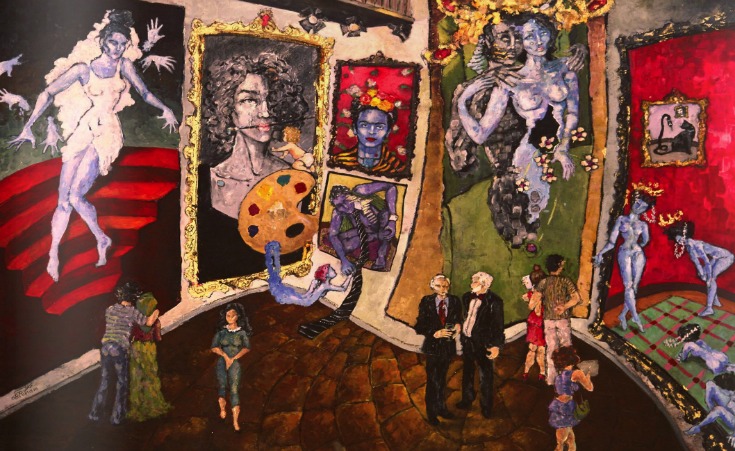Egyptian Artist Riham El Sadany On Horned Women And The Colour Blue
Sanabel al-Najjar talks to Egyptian artist Riham El Sadany about her stunning and mysterious artwork, which includes elements of etheric bodies, women power, Egyptian mythology, and intimate affinity to colours.

The classic stereotypical image of the oppressed Arab woman – her face sweating under a black piece of niqab, shrouded in layers of cloth under the heat, walking like an invisible creature under the sun – is oftentimes contrasted with the artistic image of an ever-youthful, ever-rebellious feminine and free woman. And it's within the collision of the contrasting images that we find the nuances that make up reality.
Breaking that sticky stereotype into the newfound liberation of enjoying one’s existence (especially for women) is at times achieved through artistic contexts. The heroines in Najeeb Mahfouz and Ghaleb Halasah’s novels and Mahmoud Darwish’s poetry were never timid and traditional women; they were true forces of nature that rebelled strongly against the hypocritical society that taught them that they mattered less and were of a lower value than everyone else.
Visual art also plays an integral role in flipping the sexist and stereotypical image of the weak woman into an almost mythically-strong creature, defying everything to realise her own self. Arts further humanise the woman as a person rather than just a ‘body’ or an exotified creature that needs to be freed in order to exploit.
Those little nuances and almost invisible dividing lines easily bounce off the works of Egypt’s Riham El Sadany, who, least be said, brings out the feminine beast inside every Arab woman as a gloriously beautiful depiction of her strength and majesty through her many paintings.
Scraping out some time to chat between working on her own art projects, looking out for her family, and giving art classes to university students, the brilliant artist exclaims in surprise as I ask her about why she chose to focus on painting women portraits. “Is there anything more beautiful than a woman?!” she laughed wholeheartedly. “I love painting women not because I’m fascinated with women per se but because I can feel the woman at a stronger magnitude because I’m a woman myself. I don’t try to promote a societal women-related agenda through my works, but universal human themes reflected from lived experience.”
The PhD holder explains that men’s portraits have been slowly and subconsciously emerging in her artistic productions because of her husband and the warmth of his presence in her life. “It’s not really about gender for me but about what I feel. For instance, I began painting children for the first time when I was pregnant with my daughter. It’s not really up to me or a decision I had made, but such ideas or themes will have entered my mind even in spite of me – in my subconscious. So, it is really something that’s psychologically related," the artist explains.
Sadany's painting style is very distinct, including her brush strokes, body figures and outlines, and even colours (with a focus on rich and deep blue shades) – something that fascinated me, to which she commented that “during that time I was reading about etheric bodies. Regardless of its reality and scientific soundness, I was truly drawn to the testimonies of soldiers claiming to have seen them, mostly in blue.” The intriguing concept bled into Sadany’s artwork, who loves blue for its depth and warmth “and real mystery instead of a fake pretension. Blue is not pale; it’s fresh and bold.”
“But after the blue phase, I decided to go for another colour, as I always love to change. Even the bodies I painted were never painted the way they are exactly in reality, but I would always distort them, like making them unnaturally long,” Sadany says.

Given my personal captivation by the concept of bacchantes (or horned women) in visual art, I was dying to ask Sadany about why she chose to include this enchanting concept in her artwork, as many of her women in art have horns growing out of their heads. Sadany explains that, just like in Egyptian mythology [such as with god Khnum], some gods and goddesses had horns as a symbol of strength and power. “So I add horns to the women I paint because a woman is so fragile, so they also provide her with a physical strength. So, yes, she is fascinating with a beautiful body, but she also has horns, meaning she is equally strong and even dangerous. She’s a figure that you can’t manipulate or trick,” she elaborates.

Despite the lack of support and encouragement, Sadany remained true and honest about what she loved in her life and always took her art seriously and with determination. The artist hopes that Arab women artists will always find it in themselves to make their way up in art and be patient with it and its appreciation in our Arab societies. “This path is very difficult among Arab societies and holds a lot of obstacles, but you need to patient, she concludes. "I was patient for 10 years!”
- Previous Article 4G Mobile Networks Officially Coming To Egypt
- Next Article 10 Strictly Egyptian Moustaches That Will Inspire You This Movember




























